Understanding thresholds is the fastest and easiest way to build a strong poker strategy. Many beginner and intermediate players waste countless hours pouring over post-flop hand solutions, trying to remember all the different details of the solution. In an effort to build a bulletproof poker strategy, they often end up frustrated and remembering very little.
The best players simply do not study this way. Some of the best coaching stables and CFPs use the simple idea of thresholds to rapidly develop their player’s poker strategy to a professional level. In this article, I will walk you through this simple concept so you can stop wasting valuable study time and begin making rapid progress in your own game.
Table of Contents
What are Thresholds?
If we look at the Cambridge Online Dictionary, it will tell us that a threshold is “a point at which something starts.” This is a pretty simple definition, and it is not that far off from how it applies to poker.
In poker, a threshold is a point where we start to take a particular action, such as calling, folding, or raising. You will also hear this referred to as lines of indifference.
A line of indifference is just a point where we become indifferent to taking one action or another. Often, hands that are indifferent will be shown with two actions that are mixed frequencies, such as folding a hand 25% of the time and calling the same hand 75% of the time, and will have the same EV.
Common Threshold Questions
This idea of thresholds is not new. You have likely heard people ask questions similar to the following:
- What is the worst hand you call with here?
- What is the best hand you fold?
- What is the worst hand you bet or raise for value?
- What hands are you always continuing with?
- What is the strongest hand that you start to mix with two different actions?
- What is the weakest hand you are raising and stacking off with here to three-bet?
These types of questions are at the heart of thresholds and questions you should consider every time you face a decision point.
While the concept has been around for quite some time, it wasn’t until recently, in an article from GTO Wizard, that I saw it formalized. This is likely due to recent advances in modern poker tools that have made the idea more accessible to study.
Tools like PLO Trainer and GTO Wizard group your range into hand categories like sets, overpair + flush draw, top pair, middle pair + straight draw blocker, wraps, etc. They then use data visualization techniques to enable you to see these thresholds within these hand categories quickly.

Two Important Threshold Terms
As we move forward, you should be familiar with two terms: the continuation threshold and the value raise threshold.
The continuation threshold is simply the bottom of your calling range.
It is where the calling range intersects with the folding range. You can think of this as the worst hands you are calling or the best hands you are folding.
The value raise threshold is simply the bottom of the range you raise for value.
It is where your raising range intersects with your calling range. You can think of this as the worst hands you raise for value.
How to Use Thresholds to Develop Your Poker Strategy
Let’s walk through a hand example together and learn how to use thresholds to help us start developing a solid poker strategy.
We are in the big blind with 100bb effective stacks when it folds around to the button, who makes a standard pot-size raise of 3.5bb. The small blind folds, and we call. The flop comes out Q♠8♠4♦. We check to the button who makes a 75% pot-size bet.
How do we proceed?
Questions we should be asking ourselves right now are –
- What is the strongest hand that I am folding here?
- Of my continuing range, what types of hands am I raising for value?
The first question gets at our continuation threshold. The second is related to our value raise threshold.
As discussed above, we really need a good way to visualize these thresholds across various hand categories. Let’s use PLO Trainer’s Strength Buckets view to help us here.
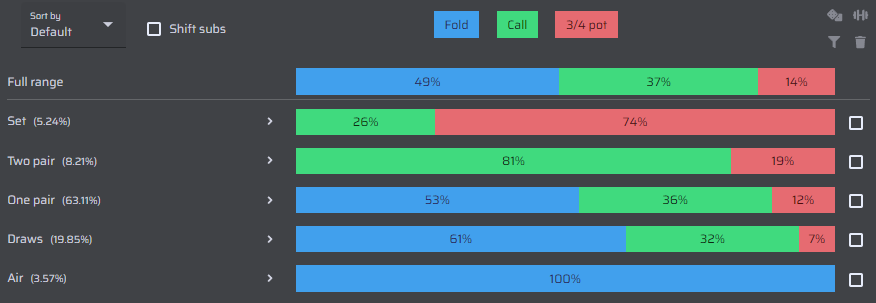
A quick look tells us we never fold a set or two pair. We can also see that we will raise most of the sets and call most of the two pairs.
The next thing we see is that we fold around half of our one pair hands and a decent chunk of our draws. We are never continuing with air, which are hands that don’t have a pair or draw.
While this might seem obvious, it is critical to take note of these aggregate-level components of our strategy.
From what we see, we can quickly see that our continuation threshold is one pair hands.
Let’s dig into our one pair hands and get a better idea of what kinds of hands we are continuing with. I will focus on our top, middle, and bottom pair hands (hands with a Q, 8, or 4).
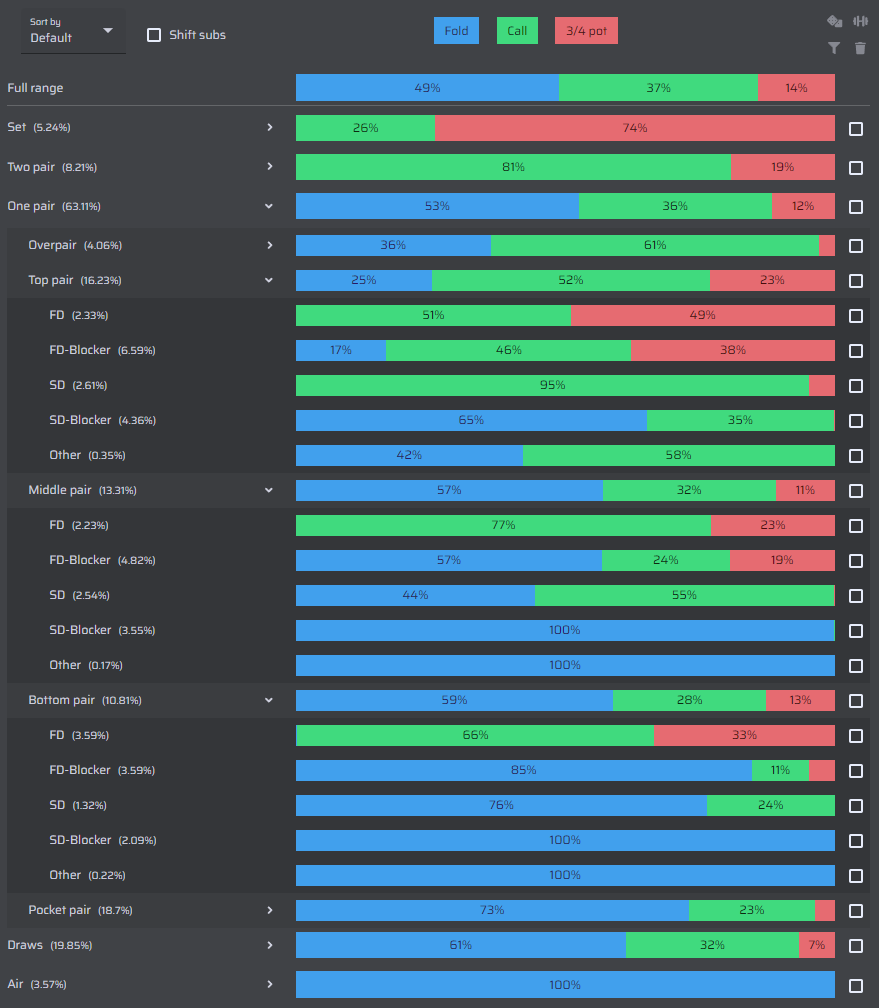
One quick takeaway is that we never fold a pair + flush draw.
Next, we can see that we fold a pair + straight draw with a very high frequency if it is not a top pair + straight draw. This will likely come as a big surprise to many. I see these hands get called and raised by many players constantly.
As we continue to dig, we see that if we do not have a draw or a flush draw blocker to go with our second or third pair, we are folding them.
Again, this might surprise many players who see hands like A♦K♥8♦2♥ as standard calls because they have a middle pair + 2 overcards + backdoor nut flush draw. I also see players call hands like this and worse all of the time.
This gives us a good idea of our continuation thresholds, but what about our value raise thresholds?
If we look at our top pair + flush draws, we see that they are evenly split between calling and raising. With so many combos, figuring out how to tackle this can be daunting. To do this, you have to start digging into the combos. It’s easiest to start with the obvious.
What do we do with our top pair + nut flush draw?
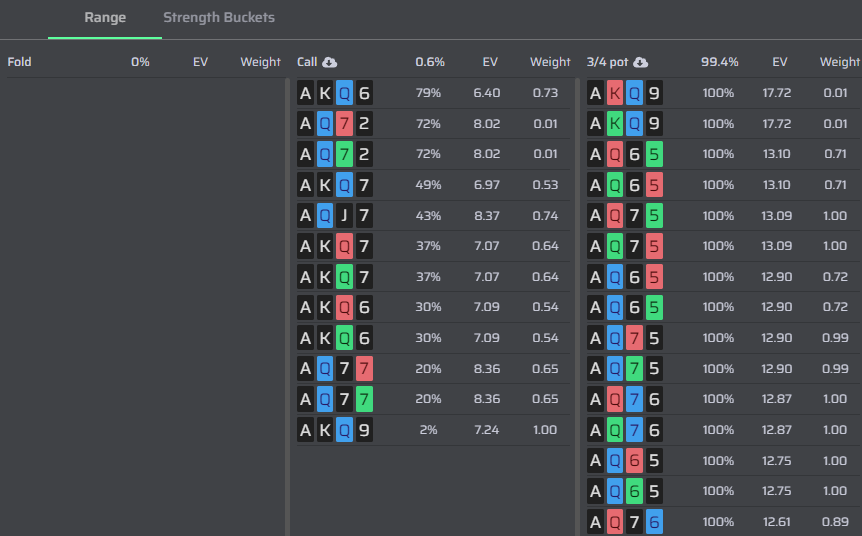
We quickly see that we are raising 99.4% of this hand category. The fraction of hands that we do raise are less than a 100% frequency. This is our threshold of indifference, as we discussed above.
Since we are looking for broad takeaways, here is a spot we can likely simplify to raising this hand category 100%.
How close did that get us? Let’s filter out our A♠ since we know we are always raising those, and see where we are at.
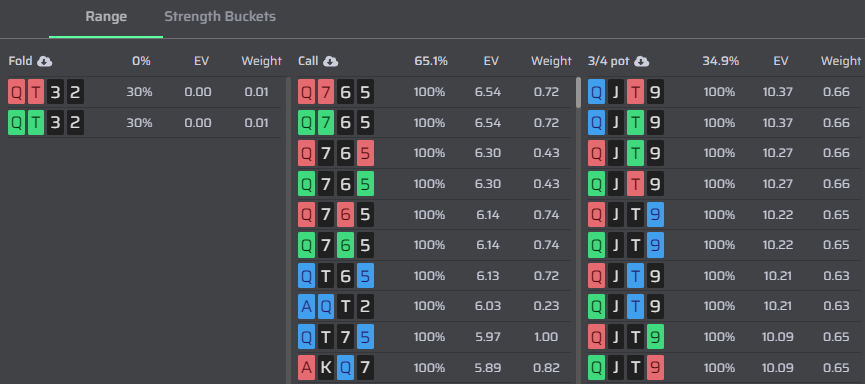
That gets us to a lower raising frequency, but we still raise 35% of the remaining hands. We can do better. Let’s see what we are doing with our K♠ hands.
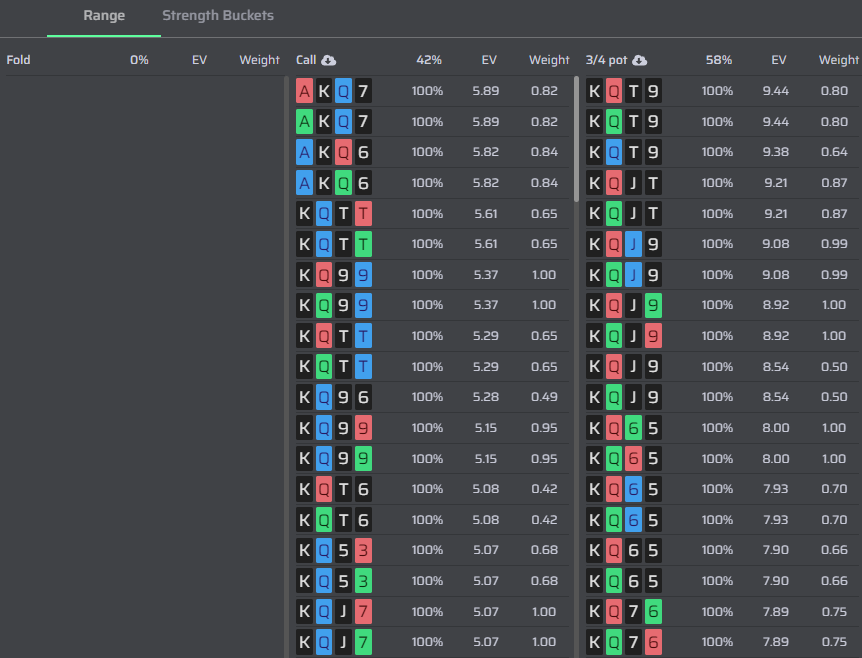
Looking at the frequencies, we see that we are still pretty heavily split. But if we look closer, a pattern starts to stick out.
Do you see it?
There are many hands in the raising column that are also straight draws. Let’s filter for those and see what we get.
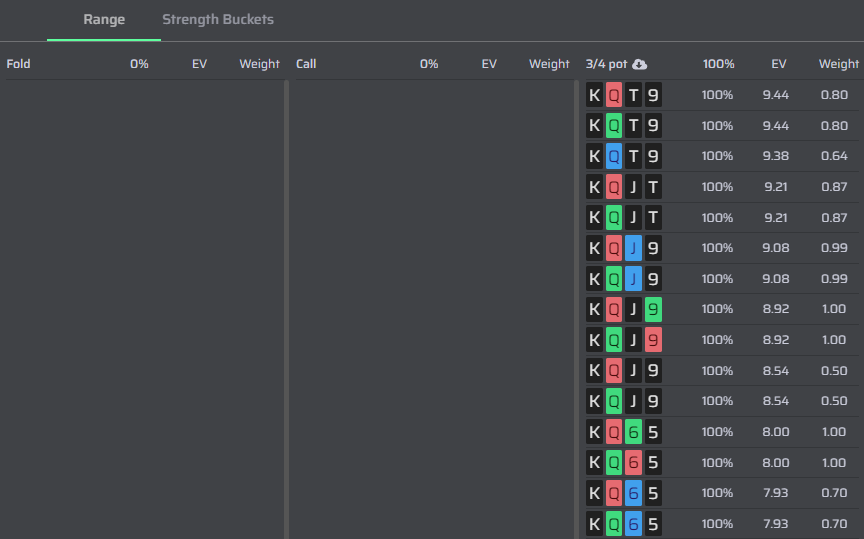
Look at that!! Another big heuristic we can take away.
We are always raising when we have a K♠ + straight draw. Let’s see how much closer that gets us by filtering that hand category out, too.
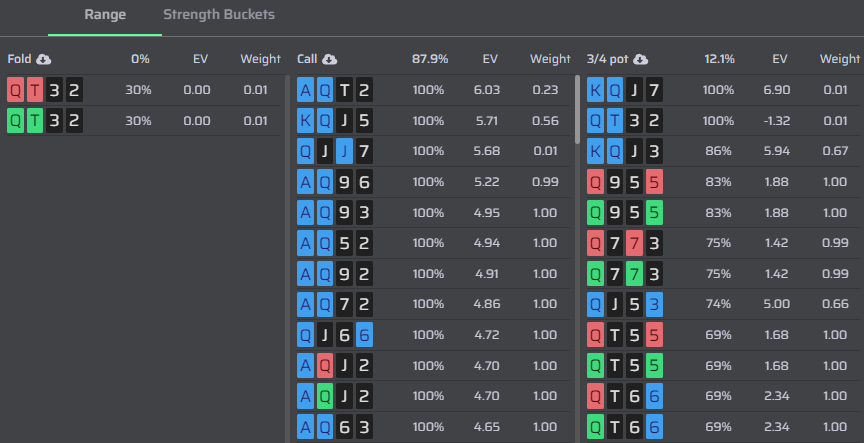
Now we are really getting somewhere. That brought us down to only a 12% value raise threshold of the remaining combos. We can also see that most of our remaining value hands are actually indifferent to raising and calling. Scanning the list shows that many hands have double-blocker components like TT, 66, 77, T7, T6, etc.
Now we have a pretty easy way to boil down the top pair + flush draw hand category. We are raising if we have an A♠ or a K♠ + straight draw. We can sprinkle in some hands with strong blockers to the straight. We can just call the rest.
This can seem tedious, but it is similar to sculpting a statue. You start with a big block of granite and slowly chisel away. You keep doing this until you have a strong strategy that is easy to remember.
You can take this process and look at draws or any other hand category you want. It is the same method.
Next, you want to compare these heuristics to similar boards and see how they hold true. Sometimes, you will find that there are small differences, and sometimes, you will find that the same hand categories have roughly the same strategy.
This back-and-forth process takes time; however, it is significantly faster and more effective than trying to study each individual hand and scrolling aimlessly through a range. Applying the idea of thresholds is the fastest way to level up your poker strategy and begin competing at a high level.
Conclusion
As we wrap up our exploration of using thresholds to develop poker strategy, let’s recap the key points we’ve covered.
- Understanding Thresholds: Thresholds in poker are points where you start to take specific actions like calling, folding, or raising. This concept simplifies decision-making and improves your poker strategy.
- Using Thresholds in Practice: Questions about the worst hand to call with, the best hand to fold, and the weakest hand to raise are central to understanding and utilizing thresholds.
- Continuation and Value Raise Thresholds: These terms help identify the bottom of your calling and raising ranges, respectively.
- Visualizing Thresholds: Tools like PLO Trainer categorize your range into hand categories and use data visualization to help you quickly see these thresholds and analyze your range to extract heuristics.
- Applying Thresholds: After extracting heuristics from analysis, you always want to see how those apply across a range of other boards. This is where your strategy begins to grow exponentially.
The concept of thresholds is a game-changer for those looking to improve their poker strategy efficiently and effectively. Instead of getting bogged down in the minutiae of individual hands, understanding and applying thresholds allows you to make smarter, quicker decisions, elevating your gameplay to a professional level.
If you want to level up your poker strategy, start incorporating the concept of thresholds into your study plan. I promise you will be amazed by the results.
If you enjoyed this article, make sure to subscribe or follow me on Twitter to stay up to date on new content. Also, check out some of my other articles below.


